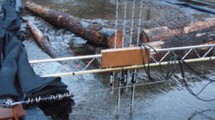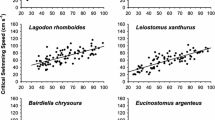Abstract
Winter flounder (Pseudopleuronectes americanus) is a benthic flatfish that is economically important for recreational and commercial fishing in North America. In the last twenty years, the species has undergone a drastic decline, mainly due to anthropic influence. The goal of this study was to gain knowledge on habitat preferences and behavior of juvenile winter flounder to improve the management of natural stocks and optimize release sites of juveniles produced for stock enhancement. Three abiotic factors (sediment, current, and salinity) potentially influencing the distribution of flatfish species were tested in a recircurlating flume with juvenile winter flounder. Time budgets of observed behaviors including swimming, orientation, and burying capacity were analyzed. Sediment texture was the only factor that significantly influenced the burying behavior of winter flounder juveniles; shear velocity, salinity, and sediment had no effect on the orientation of juveniles.



Similar content being viewed by others
References
Able KW, Fahay MP (1998) First year in the life of estuarine fishes in the middle Atlantic Bight. Rutgers University Press, New Brunswick
Arnold GP, Weihs D (1978) The hydrodynamics of rheotaxis in the plaice (Pleuronectes platessa L.). J Exp Biol 75:147–169
Atlantic States Marine Fisheries Commission (2012) Species profile: winter flounder depleted SNE/MA stock in early stages of rebuilding. ASMFC Fisheries Focus 21:4–9
Ben Khemis I, De la Noue J, Audet C (2000) Feeding larvae of winter flounder Pseudopleuronectes americanus (Walbaum) with live prey or microencapsulated diet: linear growth and protein, RNA and DNA content. Aquac Res 31:377–386. https://doi.org/10.1046/j.1365-2109.2000.00456.x
Champalbert G, Marchand J (1994) Rheotaxis in larvae and juvenile sole (Solea solea L.): influence of light conditions and sediment. J Exp Mar Biol Ecol 177:235–249. https://doi.org/10.1016/0022-0981(94)90239-9
Champalbert G, Marchand J, Le Campion J (1994) Rheotaxis in juvenile sole Solea solea (L.): influence of salinity and light conditions. Neth J Sea Res 32:309–319. https://doi.org/10.1016/0077-7579(94)90008-6
DeCelles GR, Cadrin SX (2011) An interdisplinary assessment of winter flounder (Pseudopleuronectes americanus) stock structure. J Northwest Atl Fish Sci 43:103–120. https://doi.org/10.2960/J.v43.m673
Ellis T, Howell BR, Hughes RN (1997) The cryptic responses of hatchery-reared sole to a natural sand substratum. J Fish Biol 51:389–401. https://doi.org/10.1111/j.1095-8649.1997.tb01674.x
Fairchild EA (2010) Culture of winter flounder. In: Practical flatfish culture and stock enhancement. Wiley-Blackwell, Ames, pp 101–122
Fairchild EA (2013) Bringing winter flounder back through community engagement. In: Zeiber R (ed) University of New Hampshire, New Hampshire Sea Grant College Program. UNHMP-IS-SG-13-04, Durham, 4 pp
Fairchild EA, Howell WH (2004) Factors affecting the post-release survival of cultured juvenile Pseudopleuronectes americanus. J Fish Biol 65(Supplement A):69–87. https://doi.org/10.1111/j.1095-8649.2004.00529.x
Fairchild EA, Fleck J, Howell WH (2005) Determining an optimal release site for juvenile winter flounder Pseudopleuronectes americanus (Walbaum) in the Great Bay Estuary, NH, USA. Aquac Res 36:1374–1383. https://doi.org/10.1111/j.1365-2109.2005.01355.x
Fisheries and Oceans Canada (2012) Assessment of winter flounder (Pseudopleuronectes americanus) in the southern Gulf of St. Lawrence (NAFO div. 4T). DFO Can Sci Advis Sec Sci Advis Rep 2012/016
Gerstner CL, Webb PW (1998) The station-holding performance of the plaice Pleuronectes platessa on artificial substratum ripples. Can J Zool 76:260–268. https://doi.org/10.1139/z97-192
Gibson RN (1980) A quantitative description of the behaviour of wild juvenile plaice (Pleuronectes platessa L.). Anim Behav 28:1202–1216. https://doi.org/10.1016/S0003-3472(80)80109-6
Gibson RN (1994) Impact of habitat quality and quantity on the recruitment of juvenile flatfishes. Neth J Sea Res 32:191–206. https://doi.org/10.1016/0077-7579(94)90040-X
Goldberg R, Phelan B, Pereira J, Hagan S, Clark P, Bejda A, Calabrese A, Studholme A, Able KW (2002) Variability in habitat use by young-of-the-year winter flounder, Pseudopleuronectes americanus, in three northeastern US estuaries. Estuaries 25:215–226. https://doi.org/10.1007/BF02691309
He P (2003) Swimming behaviour of winter flounder (Pleuronectes americanus) on natural fishing grounds as observed by an underwater video camera. Fish Res 60:507–514
Joaquim N, Wagner GN, Gamperl AK (2004) Cardiac function and critical swimming speed of the winter flounder (Pleuronectes americanus) at two temperatures. Comp Biochem Physiol A 138:277–285. https://doi.org/10.1016/j.cbpb.2004.03.016
Kellison GT, Eggleston DB, Burke JS (2000) Comparative behaviour and survival of hatchery-reared versus wild summer flounder (Paralichthys dentatus). Can J Fish Aquat Sci 57:1870–1877. https://doi.org/10.1139/f00-139
Kieffer JD, Arsenault LM, Litvak MK (2009) Behaviour and performance of juvenile shortnose sturgeon Acipenser brevirostrum at different water velocities. J Fish Biol 74:674–682. https://doi.org/10.1111/j.1095-8649.2008.02139.x
Lazzari MA (2015) Eelgrass, Zostera marina, as essential fish habitat for young-of-the-year winter flounder, Pseudopleuronectes americanus (Walbaum, 1792) in Maine estuaries. J Appl Ichthyol 31:459–465. https://doi.org/10.1111/jai.12713
Manderson JP, Phelan BA, Stoner AW, Hilbert J (2000) Predator–prey relations between age-1+ summer flounder (Paralichthys dentatus, Linnaeus) and age-0 winter flounder (Pseudopleuronectes americanus, Walbaum): predator diets, prey selection, and effects of sediments and macrophytes. J Exp Mar Biol Ecol 251:17–39. https://doi.org/10.1016/S0022-0981(00)00191-X
Nasir NA, Poxton MG (2001) Substratum preferences of juvenile flat fish. Cybium 25:109–117
Olivier F, Desroy N, Retière C (1996) Habitat selection and adult-recruit interactions in Pectinaria koreni (Malmgren) (Annelida: Polychaeta) post-larval populations: results of flume experiment. J Sea Res 36:217–226. https://doi.org/10.1016/S1385-1101(96)90791-1
Pappal AL, MacDonald DG, Rountree RA (2009) Evidence of cobble habitat preference in age-0 winter flounder, Pseudopleuronectes americanus. Mar Freshw Behav Physiol 42:43–53. https://doi.org/10.1080/10236240902765269
Phelan BA, Manderson JP, Stoner AW, Bejda AJ (2001) Size-related shifts in the habitat associations of young-of-the-year winter flounder (Pseudopleuronectes americanus): field observations and laboratory experiments with sediments and prey. J Exp Mar Biol Ecol 257:297–315. https://doi.org/10.1016/S0022-0981(00)00340-3
Poxton MG, Nasir NA (1985) The distribution and population dynamics of 0-group plaice (Pleuronectes platessa L.) on nursery grounds in the firth of forth. Estuar Coast Shelf Sci 21:845–857. https://doi.org/10.1016/0272-7714(85)90078-2
Redjah I, Olivier F, Tremblay R, Myrand B, Pernet F, Neumeier U, Chevarie L (2010) The importance of turbulent kinetic energy on transport of juvenile clams (Mya arenaria). Aquaculture 307:20–28. https://doi.org/10.1016/j.aquaculture.2010.06.022
Scott WB, Scott MG (1988) Atlantic fishes of Canada. In: Canadian bulletin of fisheries and aquatic sciences, 219. Fisheries and Oceans, Canada
Stoner AW, Manderson JP, Pessutti JP (2001) Spatially explicit analysis of estuarine habitat for juvenile winter flounder: combining generalized additive models and geographic information systems. Mar Ecol Prog Ser 213:253–271
Tyler AV (1971) Surges of winter flounder, Pseudopleuronectes americanus, into the intertidal zone. J Fish Res Board Can 28:1727–1732. https://doi.org/10.1139/f71-255
Vagner M, De Montgolfier B, Sévigny JM, Tremblay R, Audet C (2013) Expression of genes involved in key metabolic processes during winter flounder (Pseudopleuronectes americanus) metamorphosis. Can J Zool 91:156–163. https://doi.org/10.1139/cjz-2012-0240
Walker MG, Harden Jones FR, Arnold GP (1978) The movements of plaice (Pleuronectes platessa) tracked in the open sea. ICES J Mar Sci 38:58–86. https://doi.org/10.1093/icesjms/38.1.58
Weihs D (1978) Tidal stream transport as an efficient method for migration. ICES J Mar Sci 38:92–99. https://doi.org/10.1093/icesjms/38.1.92
Wirjoatmodjo S, Pitcher TJ (1984) Flounders follow the tides to feed: evidence from ultrasonic tracking in an estuary. Estuar Coast Shelf Sci 19:231–241. https://doi.org/10.1016/0272-7714(84)90067-2
Acknowledgements
We are grateful to the many individuals who provided technical and scientific assistance, especially Renée Gagné and Nathalie Morin. We are thankful to Dr. Elizabeth Fairchild and one anonymous referee for their constructive comments on a previous version of this manuscript. This research was supported by an NSERC (Natural Sciences and Engineering Research Council of Canada) grant (Discovery Grant RGPIN-2014-06631) to CA, an FRQNT grant, Fonds de recherche du Quebec – Nature et Technologies (Équipe PR 190063) to RT, CA, Gesche Winkler, and FO as well as by the Ressources Aquatiques Québec research network (RAQ). All experiments were conducted at the Station aquicole de Pointe-au-Père (ISMER/UQAR, 48°27′N; 68°32′W, QC, Canada), and all fish manipulations were done according to the Canadian Council of Animal Protection recommendations and protocols approved by the University’s Animal Care Committee.
Author information
Authors and Affiliations
Corresponding author
Rights and permissions
About this article
Cite this article
Provencher, T., Olivier, F., Tremblay, R. et al. Effect of sediment, salinity, and velocity on the behavior of juvenile winter flounder (Pseudopleuronectes americanus). Environ Biol Fish 101, 1483–1492 (2018). https://doi.org/10.1007/s10641-018-0793-4
Received:
Accepted:
Published:
Issue Date:
DOI: https://doi.org/10.1007/s10641-018-0793-4




